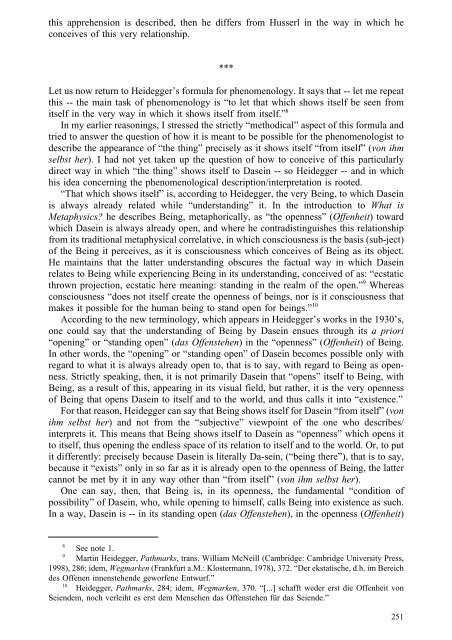[Andrzej_Wiercinski_(ed ... - WordPress.com
[Andrzej_Wiercinski_(ed ... - WordPress.com
[Andrzej_Wiercinski_(ed ... - WordPress.com
Create successful ePaper yourself
Turn your PDF publications into a flip-book with our unique Google optimized e-Paper software.
this apprehension is describ<strong>ed</strong>, then he differs from Husserl in the way in which heconceives of this very relationship.***Let us now return to Heidegger’s formula for phenomenology. It says that -- let me repeatthis -- the main task of phenomenology is “to let that which shows itself be seen fromitself in the very way in which it shows itself from itself.” 8In my earlier reasonings, I stress<strong>ed</strong> the strictly “methodical” aspect of this formula andtri<strong>ed</strong> to answer the question of how it is meant to be possible for the phenomenologist todescribe the appearance of “the thing” precisely as it shows itself “from itself” (von ihmselbst her). I had not yet taken up the question of how to conceive of this particularlydirect way in which “the thing” shows itself to Dasein -- so Heidegger -- and in whichhis idea concerning the phenomenological description/interpretation is root<strong>ed</strong>.“That which shows itself” is, according to Heidegger, the very Being, to which Daseinis always already relat<strong>ed</strong> while “understanding” it. In the introduction to What isMetaphysics? he describes Being, metaphorically, as “the openness” (Offenheit) towardwhich Dasein is always already open, and where he contradistinguishes this relationshipfrom its traditional metaphysical correlative, in which consciousness is the basis (sub-ject)of the Being it perceives, as it is consciousness which conceives of Being as its object.He maintains that the latter understanding obscures the factual way in which Daseinrelates to Being while experiencing Being in its understanding, conceiv<strong>ed</strong> of as: “ecstaticthrown projection, ecstatic here meaning: standing in the realm of the open.” 9 Whereasconsciousness “does not itself create the openness of beings, nor is it consciousness thatmakes it possible for the human being to stand open for beings.” 10According to the new terminology, which appears in Heidegger’s works in the 1930’s,one could say that the understanding of Being by Dasein ensues through its a priori“opening” or “standing open” (das Offenstehen) in the “openness” (Offenheit) of Being.In other words, the “opening” or “standing open” of Dasein be<strong>com</strong>es possible only withregard to what it is always already open to, that is to say, with regard to Being as openness.Strictly speaking, then, it is not primarily Dasein that “opens” itself to Being, withBeing, as a result of this, appearing in its visual field, but rather, it is the very opennessof Being that opens Dasein to itself and to the world, and thus calls it into “existence.”For that reason, Heidegger can say that Being shows itself for Dasein “from itself” (vonihm selbst her) and not from the “subjective” viewpoint of the one who describes/interprets it. This means that Being shows itself to Dasein as “openness” which opens itto itself, thus opening the endless space of its relation to itself and to the world. Or, to putit differently: precisely because Dasein is literally Da-sein, (“being there”), that is to say,because it “exists” only in so far as it is already open to the openness of Being, the lattercannot be met by it in any way other than “from itself” (von ihm selbst her).One can say, then, that Being is, in its openness, the fundamental “condition ofpossibility” of Dasein, who, while opening to himself, calls Being into existence as such.In a way, Dasein is -- in its standing open (das Offenstehen), in the openness (Offenheit)8See note 1.9Martin Heidegger, Pathmarks, trans. William McNeill (Cambridge: Cambridge University Press,1998), 286; idem, Wegmarken (Frankfurt a.M.: Klostermann, 1978), 372. “Der ekstatische, d.h. im Bereichdes Offenen innenstehende geworfene Entwurf.”10Heidegger, Pathmarks, 284; idem, Wegmarken, 370. “[...] schafft w<strong>ed</strong>er erst die Offenheit vonSeiendem, noch verleiht es erst dem Menschen das Offenstehen für das Seiende.”251


